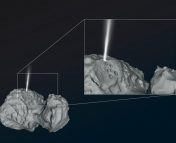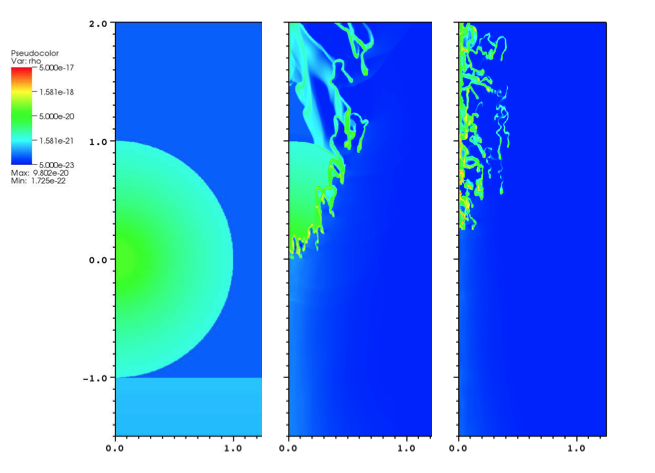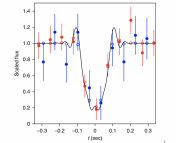- Paper Title: A Herschel Study of D/H In Water In The Jupiter-Family Comet 45P/Honda-Mrkos-Pajdusakova And Prospects For D/H Measurements With CCAT
- Authors: D. C. Lis et al
- First Author’s Affiliation: Caltech, Pasadena, CA; visiting professor, LERMA, Ecole Normale Superieure, Paris, France.
- Journal: The Astrophysical Journal Letters (Accepted)
Overview
This paper describes the measurement of the deuterium-to-hydrogen (D/H) ratio in a Jupiter-family comet, 45P. This ratio is related to the formation history of the comet and helps inform our understanding of the formation of our solar system.
Background
All elements come in different isotopes. While the number of protons an element has is fixed (indeed, that’s what defines an element), there is some flexibility in the number of neutrons. There is generally one dominant isotope because there is a single proton-to-neutron ratio that optimizes stability, but the other isotopes still exist, and studying their abundances can inform a number of studies.
So it is with hydrogen. Hydrogen’s isotopes are deuterium (D) and tritium (T), possessing 1 and 2 neutrons respectively in comparison with hydrogen’s 0. These isotopes possess the same chemical properties as H (for example, D can bond with oxygen to form heavy water), but the differing masses of the isotopes produce quantum effects that result in slightly different spectral signatures. Therefore, via high-resolution spectroscopy we can probe the abundance of these isotopes in different bodies!
The D/H ratio has been studied for the planets in our solar system. Next, scientists turned to comets. There are two families of comets: The short-period Jupiter family comets, which are thought to have been formed in the Kuiper belt relatively far away from the Sun, and the long-period Oort cloud objects, which are thought to have been formed near the giant planets and then were presumably scattered outwards.
Starting in 1997, astronomers measured the D/H ratio of 6 Oort Cloud comets. These objects all had D/H ratios of about 3e-4, a surprising consistency hinting at a common formation mechanism. This was 12 times higher than that expected for the protosolar nebula (i.e. what the Sun formed from), but lower than the D/H ratio measured for the dense interstellar medium. This suggests that the Oort cloud comets weren’t just formed out in the outer solar system, but rather that they must incorporate material from the inner part of the protosolar nebula. Turbulent processes must have transported low-D material outward to the Oort cloud.
Since the D/H measurement of those original six comets, astronomers have been looking to broaden the sample. With the launch of the immensely sensitive Herschel space telescope, they had their chance. Astronomers measured the D/H ratio of a Jupiter-family comet, 103P, and found it to be 1.6e-4. This was about half the Oort cloud comet value. Surprisingly, measurements of the Oort cloud comet C/2009 P1 also showed relatively low D/H of 2e-4.
Role Of This work
This paper presented observations of a third comet, the Jupiter-family object 45P. The authors sought to determine the D/H ratio for this object by comparing the abundance of HDO (water composed of an O, H, and D) to the more common H2O. Based on these measurements, the authors placed a 3-sigma upper bound on the D/H ratio of 2e-4. The 3e-4 value from the previous study are excluded at 4.5 sigma.
Coupled with the other Herschel observations that are also discrepant with the earlier 3e-4 value, it is clear that D/H ratios are very different across comets, not uniform as originally thought. The origin of comets is a complicated process, and no single mechanism is responsible for it. We also may not know the source regions of the comets as well as we thought; the Jovian comets, which we think to have formed in the relatively D-rich Kuiper belt, seem to have lower D/H than the Oort cloud comets!
These results are also important to our understanding of the origin of Earth’s water. One hypothesis is that Earth’s water must have come from cometary bombardment after formation, since Earth is within the ice line and little water would have been available for accretion. One problem with this hypothesis was that Earth’s oceans have a D/H ratio of 1.6e-4, which is strongly inconsistent with the 3e-4 D/H ratio measured for the original 6 Oort cloud comets. However, with the discovery of these new comets with D/H ratios more consistent with Earth’s oceans, the cometary bombardment hypothesis is significantly strengthened. We may even now be drinking comet runoff!




